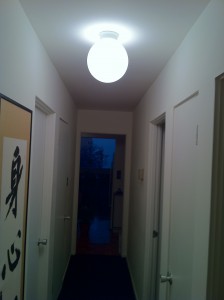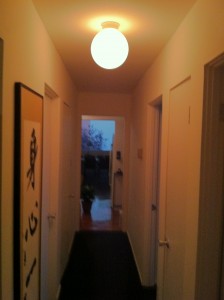Continuing the Philips prize awarded LED bulb saga,
Kevan has confirmed some dimming and the issues of the bulb as also found by the US Government L Prize test review and designated lab reports in the main post earlier.
From Save the Bulb blog, 13 May 2012
(original post has some more images)
L Prize (Fail!)
I have spent the last couple of weeks in San Francisco and taken the opportunity to observe the impact of the Californian ban on incandescent lamps that was implemented in January 2011. Basically it has had zero effect. Standard incandescent lamps are freely available through all retail supply outlets. I have checked corner stores, supermarkets, neighborhood hardware stores and DIY sheds all have a full range of conventional incandescent lamps. The “Energy Saving” options vary considerably. Most stores have a reasonable complement of CFLs some have halogen incandescent replacements but only on hardware store and the DIY sheds carry any LED incandescent replacements and just the DIY shed had the L prize lamp that I was very keen to get my hands on. These LED options are all selling in the range $17 to $24.
There has been so much store set by the quality of the L prize lamp that I was very keen to get one as it seems unlikely we will get them in the UK anytime soon. The first thing that surprised me was the extent of packaging for what is supposed to be an environmentally friendly product.
When first switched on I have to concede that the appearance of the light was OK in comparison to the GE Reveal lamp that it was replacing. The reveal is an incandescent with a slight blue tint.
As expected when dimmed things changed dramatically:....
The L prize got cooler in appearance and the perceived colour rendering became much worse casting a gloomy grey in the space. the lamp also suddenly went out about half way through the travel of the dimmer’s slider, the GE lamp dimmed right down to the minimum setting. What was really alarming was that the L prize lamp would not switch on at dimmer settings below about 70%. This was a serious problem in this location where three way switching was installed.
Really I am somewhat disappointed in a product that cost me $19.75 and does not work reliably at less than full power even when it claims to be dimmable. Solutions such as this must be made fully compatible with existing wiring infrastructure.
Another point about the massive cost for these lamps is whether or not the claimed savings are realistic in domestic use. How many people will be using the same lighting after 22 years? How many will still be living in the same house or apartment? At 58 years old I have to question whether I will still be alive to realise these claimed savings! It really is not good enough that the best of these lamp replacement products should be priced so high and fail to meet reasonable performance expectations that at least they do not risk leaving people in darkness! I do feel that the general lamp buying public are being conned into overspending for overcomplicated and ineffective products.
This page from EarthLed shows a dissection of the L prize lamp. It really does question the holistic sustainability of replacing such an elegantly simple device as the traditional incandescent lamp with something that requires computing power that would shame the flight computers of the Mercury and Gemini space programmes and has more electronic components than a transistor radio! All in all the resources used to make this thing are truly excessive for the required functionality.
Comment
The mentioned Earthled dissection of the bulb is also on the post "(S)tripping the Light Fantastic", with extensive commenting.
On the Dimming issue,
unsurprisingly it mirrors CFL problems since LEDs also have spiky emission spectra and with these LED types also use similar (phosphorescent) coating to help spread the light.
And dimming after all is also an “energy saving” benefit, that ban proponents welcome!
Dimming and other problems were as said also highlighted in the official committee test review and designated test lab reports on
“All about the new Philips LED Bulb, and how it won the L-Prize”
Renowned lighting designer and Congress lighting consultant Howard Brandston concurs on the dimming and other issues..
"The testing of this LED lamp was very narrow in scope and did not include some of the most important aspects of residential lighting.
As a lighting designer my primary concerns is the quality of the color of light emitted throughout the complete cycle of being dimmed, a common situation in homes.
In this use the lamp leaves much to be desired so I would never specify it."
A further interesting observation today (May 16) by Kevan
Apparently what I have is not the L Prize lamps but a confusing look-alike also sold by Philips!
This one is a Chinese made version, The L prize version itself is ”Assembled in the USA”.
So Philips are knocking off their own products!
The L Prize version is obviously too expensive for normal retail and is going out through specialists such as EarthLed!
... So are Philips using L Prize specs highlighted in reviews (eg a comparatively high lumen per watt efficiency), and the “kudos” from winning the L Prize, to push sales of cheaper inferior Chinese versions in ordinary stores for Joe Public who is assumed not to question quality and specs?
No! Never! ;-)


4 comments:
Is good blog at Savethebulb too Good to see it also active now!
Juan Alvarez
Do you know the CRI of the L-Price Bulb and the look-alike. I am sure the second one is lower.
@Appreciating Bulbs
That seems correct...The L-Prize bulb CRI is 93 on
Philips specs But the lookalike commercially launched Philips Endura 12W version has CRI of 80
The CRI of LEDs is a little misleading compared to smooth spectrum incandescents as it does not account for missing light frequencies and is therefore still a bother to filmmakers
Wiki summary
US Dept of Energy document
"Color Rendering Index and LEDs"
This brand always comes up with amazing variety specially of bulbs. I like their attitude towards lighting innovation.
Post a Comment